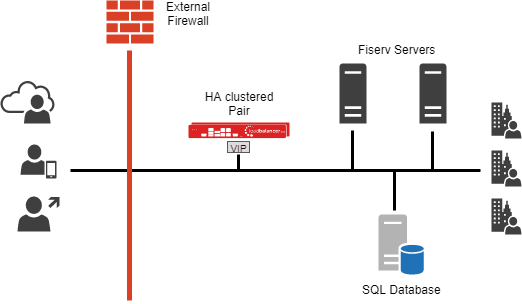Load balancing Fiserv account processing platforms

Useful resources
About Fiserv
Fiserv maintain the industry’s most diverse portfolio of account processing solutions, offering comprehensive credit union solutions tailored to meet enterprise needs and benefit customers entire operation. The Loadbalancer.org product suite is validated for use with various Fiserv account processing solutions, such as DNA, DataSafe and XP2.
Key benefits of load balancing
Loadbalancer.org specializes in providing application delivery controllers (ADC). Load balancing Fiserv ensures:
- optimized performance
- resilience (high availability)
- scalability
How to load balance Fiserv
For load balancing account processing solutions we usually recommend Layer 7 SNAT. However, Layer 4 Direct Routing (DR), aka Direct Server Return (DSR), Layer 4 NAT & Layer 4 SNAT can also be used. Deciding which method is best for your deployment depends on a variety of factors. Layer 4 DR mode is the fastest method but requires the ARP problem to be solved and also requires the application running on the real servers to respond to both its own IP address and the VIP. Layer 4 NAT mode requires that the default gateway on the real servers is the load balancer. Layer 4 SNAT mode requires no real server changes, but unlike the other Layer 4 methods, is non-transparent. Layer 7 SNAT mode is also non-transparent and requires no real server changes, but does not offer the raw throughput of the Layer 4 methods.
Source Network Address Translation (SNAT) is often used as the default mode of operation with Loadbalancer.org appliances. SNAT mode is achieved using a Layer 7 virtual service in TCP mode. In this deployment mode, the load balancer and real servers are in the same subnet, although when using Layer 7 the real server can also be remote. When the Loadbalancer.org appliance receives a request from the client it will create a second connection to the real server with the source address becoming a load balancer IP. This creates two connections as described below: Client VIP ←→ LB ←→ Real Server. You can define the source address used for the connection between LB and Real Server or leave it blank (Default) allowing it to use the load balancer’s base IP address. Should you choose to use a specific source address (SNAT Address) not already on the appliance then you will also need to add this IP address as an additional Floating IP to be used for this task.

guides

Fiserv DNA SAF Server Deployment Guide
Read deployment guide
Fiserv DNAconnect Deployment Guide
Read deployment guidemanual

Administration manual v8
Read manualcase study

Fiserv partners with Loadbalancer.org to improve uptime in business-critical financial applications
Read case study

